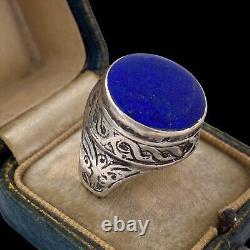
- Home
- Brand
- Art Nouveau (4)
- Bold Bloc Design (6)
- Camerden Forster (2)
- Erhard & Sohne (2)
- Grès De Charenton (2)
- Handcrafted (2)
- Handmade (7)
- Herve Lelong (6)
- Karlsbad (3)
- Kayserzinn (4)
- Makenier (3)
- Mundia (2)
- No Brand / Generic (11)
- Nsp (2)
- Rosenthal (2)
- Starling (6)
- Unknown (2)
- Villeroy & Boch (4)
- Vintage (4)
- Wilhelm Kagel (2)
- Other (3253)
- Features
- Gender
- Material
- Period
- Size
Antique Vintage Art New Silver Sterling Afghan Lapis Lazuli Ring S 6.5 9.6g







Antique vintage art new sterling silver Afghan lapis lazuli ring s 6.5 9.6g. This product sheet is originally written in English. Please find below a machine translation in French. If you have any questions please contact us. We have similar Etruscan articles and art nouveau, which would fit well with this piece, on sale this week. Description of the ad by: angela a. Markings: unmarked, tested and guaranteed.
Measurements/color of the main stone. Colour: opaque blue tint with darker marbling blue tints and golden speckling. Measurements/color of the accent stone. Stone treatment: the stone or stones seem not to have been treated, but we are not certified gemologists.
The stones were tested and guaranteed using a professional refraction, heat and hardness tester presidium duo. Measurements of the side of the ring. Handcrafted at the time art nouveau, probably in Afghanistan on the basis of design. Created like a ring, this stone has not yet been cut. Has a beautiful stone of lapis-lazuli with deep blue shade and golden spots that make this stone so striking. The lapis-lazuli rests in a bezel crimping, which was hand chiseled to represent a fluid noud pattern. The shoulders of the ring are accentuated by leafy motifs. Polished stripe for a comfortable wear. Damage: wear adapted to age. The tarnishing of sterling silver can be removed with polishing, if desired. The price was reduced to reflect this. This list is for the article only. Not all photo displays and/or accessories are provided with your purchase. This was true because of the beautiful designs that emerged from this period.This time was inspired by the beauty of women and the natural world, and the resulting pieces were often large and elegant. The enamel was a material commonly used in art nouveau jewellery, as the period emphasized the importance of design in relation to the materials used to create it. The art nouveau period took place before the beginning of the First World War, when mass manufacturing took over the production of many products, including some jewellery. Ancient Turkish, Islamic and Bedouin jewels all share similar ancestral and stylistic roots and have been influenced by trade for many years. This can be largely attributed to the expansion of the Ottoman Empire, which valued art and crafts, and promoted the pursuit of Arab arts and calligraphy.
The reign of Ottomans in the xvie and xvii centuries introduced Turkish motifs into Islamic motifs and nomadic Bedouin culture, merging a range of styles into beautiful arabesques; repeating rhythmic motifs, which often include floral and organic geometric motifs. The cavalries have a long and royal history, their first use going back to mesopotamia around 3500 B. Although the drawings and patterns of the chivalry have changed and evolved since that time, their uses have remained the same. Equestrians were mainly used as an identification mark for the powerful in order to safely seal important documents.
For much of the history, a wax seal was a sign of validity more certain than a signature. Often, the cavalries were destroyed at the death of the individual who owned them in order to prevent fraudulent documents from appearing with their approval mark.
To this day, the chimes are a sign of authenticity and power, making it an ideal complement to any collection of antiques. Praised for its intense blue colour and unique golden spots, the lapis-lazuli has been extracted since about 7,000 BC. Some of the oldest and most beautiful lapis-lazuli mines are located in Afghanistan, particularly in the province of Badakhshan, where several mines are still in operation. From the civilization of the valley of the indus to the ancient Egyptians and the artists of the medieval Europe, the lapis-lazuli was a very prized and sought after stone. Popular not only in jewellery, lapis-lazuli has also been reduced to powder by renaissance artists, who used it to create the expensive overseas blue pigment used in oil paintings. Throughout human history, lapis-lazuli has been carved and transformed into sandstone, jewellery and other decorative objects. Its rich blue pigment and its catchy golden spots make the stone very popular in ancient and modern jewels. All items are shipped within one business day of receipt of payment.We do not underestimate packages for customs, please do not ask us to do so. What you pay is what we will ask on your customs form.
Please take this into account before placing your bid. If you need more time to pay, please contact us before you bid. Throughout human history, lapis-lazuli has been carved and transformed into sandstone, jewellery and.
This item is in the category "Bijoux, watches\joaillerie\bagues\autres". The seller is "abeautifultimeco" and is located in this country: us. This item can be shipped to the following country: whole world.
-
Ancient: yes
- style: cocktail Number of gemstones: 1
- modified object: without
- metal purity: 925
- main stone colour: blue Jewellery department: fine
- metal: fine money
- country/region of manufacture: unknown Age: art nouveau (1895-1910)
- vintage: yes Department: adult unisex Size: 6.5 Type: ring Mark: - no mark/generic - Dominant stone: lapis lazuli
- original/reproduction: original

